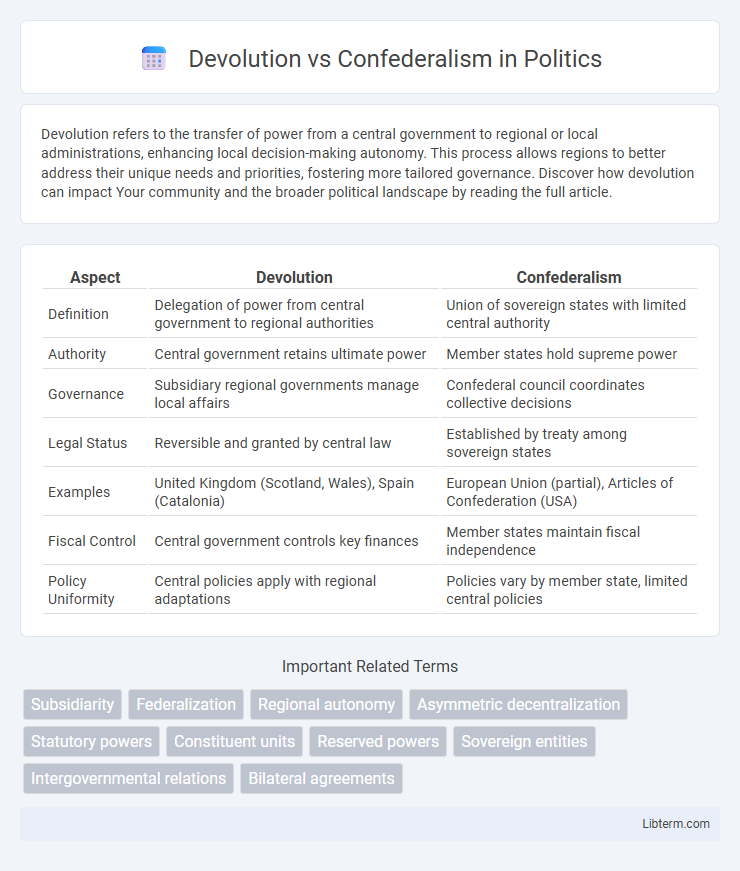Devolution refers to the transfer of power from a central government to regional or local administrations, enhancing local decision-making autonomy. This process allows regions to better address their unique needs and priorities, fostering more tailored governance. Discover how devolution can impact Your community and the broader political landscape by reading the full article.
Table of Comparison
| Aspect | Devolution | Confederalism |
|---|---|---|
| Definition | Delegation of power from central government to regional authorities | Union of sovereign states with limited central authority |
| Authority | Central government retains ultimate power | Member states hold supreme power |
| Governance | Subsidiary regional governments manage local affairs | Confederal council coordinates collective decisions |
| Legal Status | Reversible and granted by central law | Established by treaty among sovereign states |
| Examples | United Kingdom (Scotland, Wales), Spain (Catalonia) | European Union (partial), Articles of Confederation (USA) |
| Fiscal Control | Central government controls key finances | Member states maintain fiscal independence |
| Policy Uniformity | Central policies apply with regional adaptations | Policies vary by member state, limited central policies |
Introduction to Devolution and Confederalism
Devolution refers to the delegation of powers from a central government to regional or local authorities while the central government retains ultimate sovereignty. Confederalism is a political system where multiple sovereign states unite for common purposes but maintain independent authority and autonomy. Both systems emphasize distribution of power but differ significantly in the degree of central control and legal authority.
Defining Devolution: Key Features
Devolution involves the statutory delegation of powers from a central government to regional or local authorities, allowing them to exercise certain legislative, administrative, or fiscal functions independently while the central government retains sovereignty. Key features include the reversible nature of power transfer, limited autonomy constrained by constitutional or legal frameworks, and the absence of full sovereignty for devolved units. Unlike confederalism, devolution typically occurs within a unitary state structure where the central authority holds ultimate control.
Understanding Confederalism: Essential Characteristics
Confederalism is a political system where multiple sovereign states unite under a weak central authority that primarily handles issues delegated by member states. Its essential characteristics include the preservation of state autonomy, limited central government powers, and decision-making that requires consensus or agreement among member states. This arrangement contrasts with more centralized federal systems by emphasizing decentralized governance and strong state sovereignty.
Historical Contexts of Devolution and Confederalism
Devolution emerged prominently in the United Kingdom during the late 20th century, granting Scotland, Wales, and Northern Ireland varying degrees of self-governance while maintaining the United Kingdom's sovereignty. Confederalism has roots in the formation of the Swiss Confederation in the 13th century and was embodied in the Articles of Confederation of the United States (1781-1789), where sovereign states delegated limited powers to a central authority. These historical contexts illustrate that devolution operates within a unitary state framework, whereas confederalism involves voluntary alliances of independent states with retained sovereignty.
Governance Structures: Comparing Devolved and Confederal Systems
Devolution establishes a unitary state where central government grants powers to subnational units, which remain politically subordinate and can have powers revoked. Confederalism features independent sovereign states forming a loose alliance with limited powers delegated to a central authority, maintaining greater autonomy. Governance structures in devolved systems emphasize hierarchical control, while confederal arrangements prioritize intergovernmental cooperation and consensus among member states.
Distribution of Power: Central vs. Regional Authority
Devolution grants regional governments limited autonomy with the central government retaining ultimate authority, allowing regions to manage local affairs while the central state controls key national policies. Confederalism establishes a weaker central authority, with member states or regions possessing significant sovereignty and the power to override central decisions, reflecting a union of independent entities. The balance of power in devolution is more centralized, whereas confederalism emphasizes regional authority and state independence.
Impact on National Unity and Sovereignty
Devolution grants autonomous powers to regional governments while maintaining national sovereignty, often strengthening unity by accommodating diversity within a single state framework. Confederalism, by contrast, involves a looser union of sovereign states that retain full independence, which can challenge national unity due to competing allegiances and weakened central authority. The impact on sovereignty in devolution is limited, preserving the central government's ultimate authority, whereas confederalism significantly decentralizes sovereignty, risking fragmentation and diminished national cohesion.
Real-World Examples of Devolution and Confederalism
The United Kingdom exemplifies devolution, granting Scotland, Wales, and Northern Ireland varying degrees of legislative autonomy while retaining sovereignty under the UK Parliament. Switzerland demonstrates confederalism through its decentralized cantonal system, where cantons maintain significant independence and sovereignty, cooperating under a weak federal government. These models highlight the practical differences: devolution involves power delegation within a unitary state, whereas confederalism features a union of sovereign entities with limited central authority.
Advantages and Challenges of Each System
Devolution grants regional governments autonomous powers while remaining under central authority, offering flexibility to address local needs and promote political stability but often facing challenges in limited fiscal independence and potential central interference. Confederalism provides member states with substantial sovereignty and control, fostering strong regional identity and cooperation, yet struggles with weak central authority, coordination issues, and potential fragmentation risks. Both systems balance power distribution differently, impacting governance efficiency, national unity, and policy implementation.
Choosing Between Devolution and Confederalism: Key Considerations
Choosing between devolution and confederalism requires analyzing the degree of autonomy desired by subnational entities and the central government's power retention. Devolution grants limited self-governance while maintaining strong central authority, suitable for unitary states seeking administrative efficiency. Confederalism offers greater sovereignty to member states with a weak central body, ideal for alliances prioritizing state independence and collective decision-making.
Devolution Infographic

 libterm.com
libterm.com